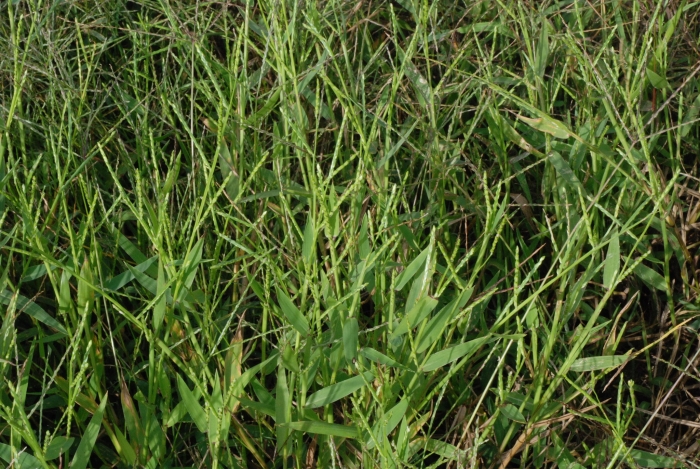Broadleaf Signalgrass
(Urochloa platyphylla)
Broadleaf Signalgrass (Urochloa platyphylla)
/
/

Douglas Goldman
CC BY-SA 4.0
Image By:
Douglas Goldman
Recorded By:
Copyright:
CC BY-SA 4.0
Copyright Notice:
Photo by: Douglas Goldman | License Type: CC BY-SA 4.0 | License URL: http://creativecommons.org/licenses/by-sa/4.0/ | Rights Holder: Douglas Goldman | Publisher: iNaturalist | Date Created: 2011-09-26T16:46:38-07:00 |

















Estimated Native Range
Summary
Urochloa platyphylla, commonly known as broadleaf signalgrass, is an annual grass native to tropical regions of the Americas, including savannas, open woodlands, and disturbed sites. It has a prostrate growth habit, forming dense mats that can reach up to 1.5 meters in width. The plant features broad, flat leaves and produces small, inconspicuous flowers during the warm season. Broadleaf signalgrass is known for its rapid growth and ability to thrive in a variety of soil conditions.
Broadleaf signalgrass is often used for erosion control due to its mat-forming growth habit and is also planted as forage in pastures. It prefers full sun but can tolerate partial shade and requires minimal water once established, making it a low-maintenance option for suitable climates. However, its aggressive growth can lead to it becoming invasive outside its native range, outcompeting native vegetation and altering ecosystems. Gardeners should be cautious and check local regulations before planting.CC BY-SA 4.0
Broadleaf signalgrass is often used for erosion control due to its mat-forming growth habit and is also planted as forage in pastures. It prefers full sun but can tolerate partial shade and requires minimal water once established, making it a low-maintenance option for suitable climates. However, its aggressive growth can lead to it becoming invasive outside its native range, outcompeting native vegetation and altering ecosystems. Gardeners should be cautious and check local regulations before planting.CC BY-SA 4.0
Plant Description
- Plant Type: Grass
- Height: 1.5-3 feet
- Width: 2-3 feet
- Growth Rate: Moderate, Rapid
- Flower Color: N/A
- Flowering Season: Summer, Fall, Winter
- Leaf Retention:
Growth Requirements
- Sun: Full Sun, Part Shade
- Water: Medium
- Drainage: Medium, Slow
Common Uses
Erosion Control, Low Maintenance, Water Garden
Natural Habitat
Native to tropical savannas, open woodlands, and disturbed sites in the Americas
Other Names
Common Names: Para Grass, White Para Grass
Scientific Names: , Urochloa platyphylla, Brachiaria extensa, Brachiaria platphylla, Brachiaria platyphylla, Panicum platyphyllum, Panicum platyphyllum, Paspalum platyphyllum, Urochloa extensa,
GBIF Accepted Name: